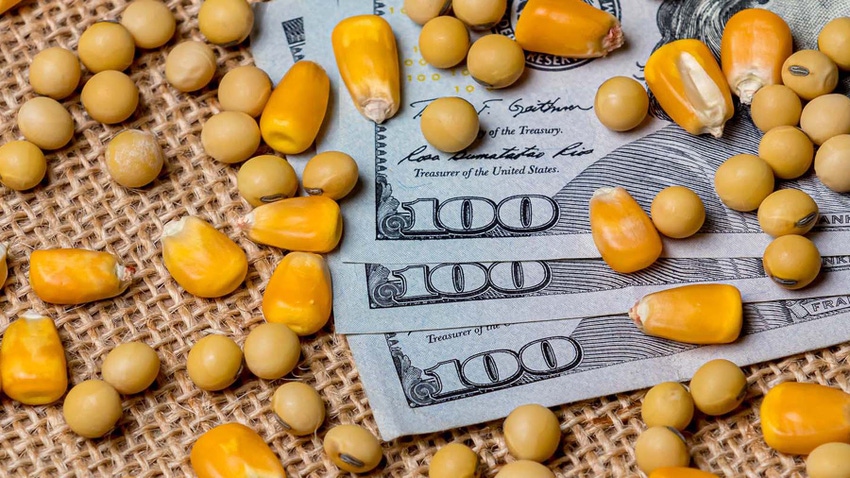
As we approach the Feb.1 start for the period when projected prices for 2024 crop insurance will be established, we’re watching several factors that can impact current predictions of lower year-on-year prices for corn and soybeans.
For example, the projected price for corn in 2023 was $5.91, while the final yield was a record 177.3 bushels per acre. For soybeans, the projected price a year ago was $13.76 and the final yield was 50.6 bpa.
Corn and soybean projected prices trended higher from 2021-23 as ending stocks have tightened. For example, the projected price for corn in 2020 was only $3.88, while the price for beans that year was $9.17.
Since 2013, the national U.S. corn average corn yield has increased 12% while the national average soybean yield has risen 15%.
Even though both December 24 corn and November 24 soybean futures prices have been trending low over the last three months (see graph below), much could change over the next many weeks. Several changes may occur on the supply and demand sides, potentially creating more volatility in the market.
Smaller South American crops?
On the supply side, soybean production estimates from Brazil appear to be declining, although production prospects remain optimistic in Argentina.
Since the last WASDE report was released on Jan. 12, initial low yields for early planted soybeans and first corn crop in Brazil have led to various agencies reducing their production estimates for the 2023-24 market year. With only 10.4% and 8.6% of first crop corn and soybeans harvested in Brazil during the week ending Jan. 27 (Conab), final yields are still unknown in the country. However, the observed periods of dryness and high temperatures that affected crops in key-producing regions early in the season are resulting in successive cuts in Brazilian corn and soybean production.
For corn, even though the safrinha crop (around 77% of total production) is only 10.3% planted in Brazil, total corn production estimates seem to be closer to official estimates from Conab’s 117.6 MMT than to the USDA’s 127 MMT figure. For soybeans, various agencies are already estimating production below 150 MMT, versus Conab’s 155.3 MMT, and USDA’s 157 MMT.
Lower estimates for Brazilian production have been partially offset by increases in corn and soybean production estimates in Argentina. With corn and soybean planting nearly complete in the country, weather seems to be cooperating for Argentine producers to recover from a very bad 2022-23 crop year.
As of Jan. 24, according to the Buenos Aires Grain Exchange (BAGE), corn and soybean production rated as good-to-excellent in the country is currently above last year’s ratings (corn, 41% this year versus 12% last year; soybeans, 44% versus 7%). As a result, the USDA expects soybean production to double in 23/24, from 25 MMT to 50 MMT, and corn production to increase by 62%, from 34 MMT to 55 MMT.
Local agencies seem to be even more optimistic with Argentina’s recovery, with both BAGE and Rosario Grain Exchange expecting record corn production of 56.5 MMT and 59 MMT, respectively. For soybeans, BAGE’s current estimate is 2.50 MMT above the January WASDE number.
U.S. export threats breed uncertainty
On the demand side, uncertainty regarding the future of U.S. exports may continue through a good part of 2023. The recovery of the Chinese economy has not been sustainable enough to bring optimism to the market, which may affect the exports of U.S agricultural products.
Other signs have recently raised red flags for upcoming Chinese demand. For example, soybean meal futures prices on the Dalian Exchange fell nearly 12% over the past month and soybean crush in China has been below 2 MMT/week since the end of November, largely due to ongoing losses in the port industry. Additionally, soybean meal demand in the country has weakened as a result of a declining SBM inclusion rate in animal diets and a reduction in herd size, while corn imports face a potential reduction due to higher domestic production.
Moreover, competition with cheaper South American corn and soybean exports will likely continue to be a major threat to U.S. exports, potentially increasing corn and soybean ending stocks and putting more pressure on prices.
Additional changes to the market may also occur in response to these events:
Feb. 8: USDA releases of an updated supply/demand report
Feb. 15-16: the annual Agricultural Outlook Forum releases updated U.S. balance sheets for 2024-25.
With such reports potentially affecting the corn and soybean markets, price risk management tools are crucial to protect producer balance sheets. Even though crop insurance is an integral part of a comprehensive production plan, it should be incorporated in conjunction with a risk management strategy that provides market flexibility.
For this purpose, futures and options contracts are excellent tools to limit potential market losses and keep gain possibilities open in the future.
Contact Advance Trading at (800) 747-9021 or go to www.advance-trading.com.
Information provided may include opinions of the author and is subject to the following disclosures:
The risk of trading futures and options can be substantial. All information, publications, and material used and distributed by Advance Trading Inc. shall be construed as a solicitation. ATI does not maintain an independent research department as defined in CFTC Regulation 1.71. Information obtained from third-party sources is believed to be reliable, but its accuracy is not guaranteed by Advance Trading Inc. Past performance is not necessarily indicative of future results.
The opinions of the author are not necessarily those of Farm Futures or Farm Progress.
About the Author(s)
You May Also Like








